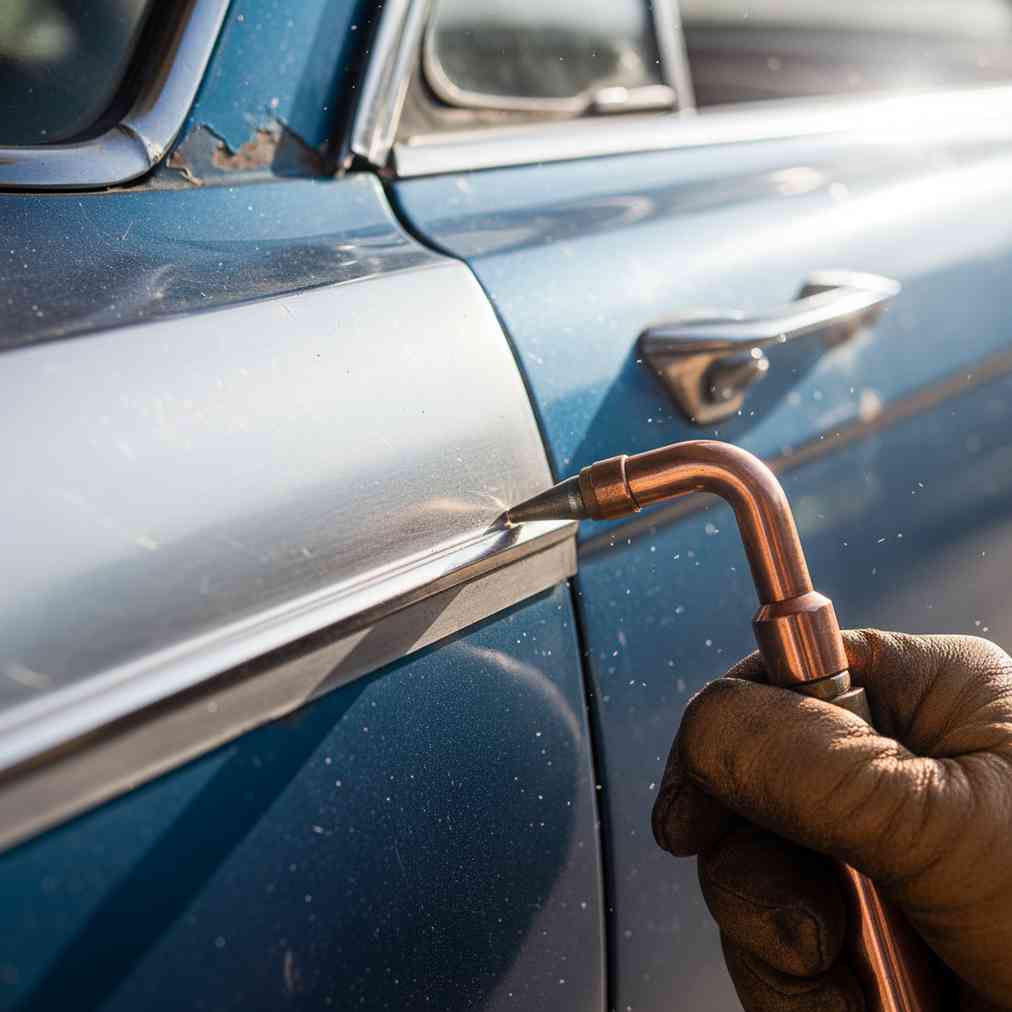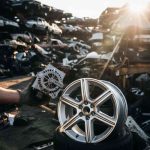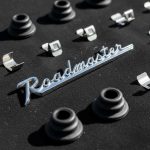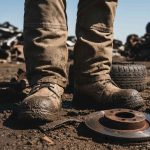Understanding Body Panel Repair with Used Patch Panels
Repairing automotive body panels using patch panels sourced from salvage yards is a practical, cost-effective way to restore rusted or damaged areas, especially on classic or older vehicles. This comprehensive approach combines traditional metalworking skills with modern technology to achieve professional-quality results at a fraction of the cost of new parts.
The process involves identifying suitable patch panels, precise cutting, skilled welding, and proper finishing techniques. With the integration of AI-powered part identification tools, finding the right components at salvage yards near you has become more efficient than ever before.
Selecting and Preparing Patch Panels from Salvage Yards
Successfully sourcing quality patch panels from salvage yards requires a keen eye for detail and understanding of what makes a good repair piece. Here’s what to look for when selecting crash repair parts:
- Metal condition: Look for panels with minimal rust or damage
- Gauge matching: Ensure the thickness matches your original panel
- Structural integrity: Check for stress cracks or previous repairs
- Fit compatibility: Verify the panel matches your vehicle’s year, make, and model
Using pre-formed panels is often simpler than building patch panels from scratch. The fitment is closer to original specifications, reducing cutting and shaping time significantly. Professional body repair experts emphasize that spending more time on proper fitting results in less welding and finishing work.
Essential Cutting Techniques and Preparation
Proper cutting technique is crucial for achieving seamless repairs. The first critical step is to cut out all the “cancer” – meaning all rusted metal from the original panel.
| Cutting Tool | Best Use | Advantages |
|---|---|---|
| Angle Grinder with Cut-off Wheel | Straight cuts, removing large sections | Fast, precise cuts |
| Metal Nibblers | Curved cuts, detailed work | Clean edges, minimal heat |
| Air-powered Tools | Professional applications | Consistent results, reduced fatigue |
Key preparation steps include:
- Mark the damaged area precisely with a marker
- Create cardboard templates for irregular shapes
- Cut the patch panel slightly larger than the hole
- Grind the area on the original panel down to bare metal
- Test fit multiple times before welding
Professional Welding Methods and Heat Control
Welding thin sheet metal requires careful heat management to prevent warping and distortion. Professional repair techniques focus on controlling heat as the primary concern when welding automotive body panels.
Butt Welding vs. Lap Welding
Butt welding is the preferred method for rust repair on floor, quarter, and body panels because it creates stronger, seamless joints and prevents moisture pocket formation. While lap welding is faster, it carries a higher risk of trapped moisture leading to future rust problems.
“Butt welding creates seamless joints with no gaps, eliminating potential rust spots and delivering superior results.”
MIG Welding Specifications
- Use 0.025-inch wire for 24-gauge metal
- Recommended gas mixture: 75% argon / 25% CO2
- Gas flow rate: 10 L/min for optimal results
- Start with tack welds spaced evenly
- Stitch weld between tacks to minimize heat buildup
TIG Welding Advantages
TIG welding offers less warpage and distortion compared to MIG, especially when performing continuous passes. This method ensures full penetration and provides superior control over heat input.
AI-Powered Part Identification Revolution
The automotive repair industry is experiencing a technological revolution with AI image recognition tools transforming how we identify and source used parts. This technology is crucial because part numbers on salvage components are often illegible, scratched, painted over, or missing entirely.
Benefits of AI Part Identification
- Efficiency: Significantly reduces identification time
- Accuracy: Achieves up to 98.9% recognition accuracy
- Compatibility assurance: Cross-references with extensive databases
- Reduced returns: Guarantees proper fitment
Photo-Taking Best Practices for AI Recognition
To maximize AI identification accuracy, follow these photography guidelines:
- Lighting: Use bright, natural light to eliminate shadows
- Focus & Resolution: Ensure sharp focus with high-resolution cameras
- Multiple Angles: Capture front, back, edges, and mounting areas
- Context: Include vehicle make, model, and year information
- Clean Background: Use neutral, uncluttered backgrounds
Advanced Finishing Techniques
Proper finishing separates amateur repairs from professional-quality work. The goal is achieving a smooth, flush finish that’s virtually undetectable once painted.
Post-Weld Processing
- Grinding: Grind welds but don’t make them completely flat to maintain strength
- Metal Finishing: Use hammer and dolly work to restore original contours
- Seam Preparation: Tap down seams to create a buffer for filler application
“You want a little bit of a buffer between the seam and the finish; filler works very well for that.”
Filler Application and Surface Prep
- Use lightweight body filler sparingly
- Sand with appropriate grits (start with 80-grit, finish with 320-grit)
- Apply gray filler primer for even coating
- Final sand with 600-grit before paint
Cost-Effectiveness and Environmental Benefits
Using salvage patch panels provides significant economic and environmental advantages. When you need to get cash for your junk car or find affordable repair solutions, understanding these benefits helps make informed decisions.
| Benefit Category | Savings | Environmental Impact |
|---|---|---|
| Manufacturing Costs | Up to 80% savings | Reduced energy consumption |
| Material Consumption | Up to 90% reduction | Less raw material extraction |
| Market Projection | $13.5 billion by 2027 | Increased recycling rates |
Expert Tips for Success
Professional body repair experts share these crucial insights for successful patch panel repairs:
- Patience is key: Rushing the fitting process leads to more work later
- Heat management: Use copper or aluminum heat sinks for larger patches
- Safety first: Always disconnect the car battery before welding
- Rust prevention: Apply rust inhibitor and primer immediately after welding
- Quality over speed: Take time to achieve proper penetration on all welds
“Patch panels seem like a huge task, but you’d be shocked at how basic the process really is… fitting the panel perfectly is the most important factor.” – H&H Classic Parts
Common Mistakes to Avoid
Learning from common errors can save time, money, and frustration:
- Inadequate rust removal: Leaving any rust will cause future problems
- Poor fit preparation: Rushing the fitting process leads to welding difficulties
- Excessive heat input: Causes warping and distortion
- Surface welding: Insufficient penetration leads to weak joints
- Skipping primer: Exposed metal will rust quickly
Future Trends in Salvage Part Repair
The automotive repair industry continues evolving with new technologies and techniques:
- Enhanced AI recognition: More accurate part identification and compatibility matching
- Advanced welding equipment: Better heat control and precision
- Improved materials: Better primers and rust inhibitors
- Digital documentation: Better tracking of repair procedures and outcomes
As the market for used auto parts continues growing, understanding these repair techniques becomes increasingly valuable for both professional shops and DIY enthusiasts. Whether you’re working with affordable used car doors or complex quarter panels, mastering these fundamental skills ensures successful, long-lasting repairs.
The combination of traditional metalworking skills and modern AI-assisted part identification creates new opportunities for efficient, cost-effective vehicle restoration. By following these proven techniques and embracing new technologies, repair professionals can deliver exceptional results while keeping costs manageable for vehicle owners.





Leave a Reply
You must be logged in to post a comment.